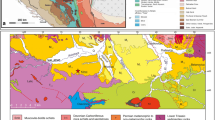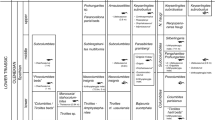Abstract
The 18 ichnospecies of the vertically oriented, helical marine to marginal marine trace fossil Gyrolithes Saporta, 1884 known so far are revised. A new ichnospecies, G. lorcaensis isp. n. (Miocene, SE Spain), is introduced, and Conispiron Vialov, 1969 and Spirocircus Mikuláš and Pek, 1994 are included in Gyrolithes. The ichnotaxobases of the Gyrolithes ichnospecies are based on the character of the burrow margin (presence or absence of a wall or ornamentation) and/or on morphometric parameters (burrow width versus radius of the whorls). As a result of synonymization, 13 ichnospecies are recommended. The morphometric parameters of Gyrolithes show two distinct lineages (large ratio of whorl radius to burrow width and medium ratio of whorl radius to burrow width; 10–12 and 1–1.6, respectively). The third lineage (small ratio of whorl radius to burrow width; up to 1) is less distinct.
Similar content being viewed by others
References
Akpan, E.B. and Nyong, E.E., Trace fossils assemblage and depositional environment of Turonian calcareous sandstones in the southern Benue Trough, Nigeria, J. Afr. Earth Sci., 1987, vol. 6, no. 2, pp. 175–180.
von Ammon, L., Über das vorkommen von “Steinschrauben” (Daemonhelix) in der Oligicänen Molasse Obernbayerns [about occurrences of the “stone screws” (Daimonelix) in the Oligocene molasse of the Upper Bavaria], Geognostische Jahreshefte, 1900, vol. 13, pp. 55–69.
Berger, W., Eine spiralförmige Lebensspur aus dem Rupel der Bayerischen Beckenmolasse [A spiral-shape trace fossil from the Ruppelian of the Bavarian molasse basin], N. Jb. Geol. Paläont. Mh., 1957, vol. 1957, pp. 538–540.
Bertling, M., Braddy, S., Bromley, R.G., et al., Names for trace fossils: a uniform approach, Lethaia, 2006, vol. 39, pp. 265–286.
Beynon, B.M., Pemberton, S.G., Bell, D.D., and Logan, C.A., Environmental implications of ichnofossils from the Lower Cretaceous Grand Rapids Formation, Cold Lake oil sands deposit, Can. Soc. Petrol. Geol. Mem., 1988, vol. 15, pp. 275–290.
Bown, M.T. and Kraus, M.J., Ichnofossils of the alluvial Willwood Formation (Lower Eocene), Bighorn Basin, Northwest Wyoming, USA, Palaeogeogr. Palaeoclimat. Palaeoecol., 1983, vol. 43, pp. 95–128.
Bromley, R.G., Trace Fossils: Biology, Taphonomy and Applications. 2nd ed., London: Chapman and Hall, 1996.
Bromley, R.G. and Frey, R.W., Redescription of the trace fossil Gyrolithes and taxonomic evaluation of Thalassinoides, Ophiomorpha and Spongeliomorpha, Bull. Geol. Soc. Denmark, 1974, vol. 23, pp. 311–335.
Dworschak, P.C. and de Rodríguez, S.D.A., A modern analogue for the trace fossil Gyrolithes: burrows of the thalassinidean shrimp Axianassa australis, Lethaia, 1997, vol. 30, no. 1, pp. 41–52.
Fedonkin, M.A., Belomorskaya biota Venda (dokembriyskaia besskeletnaya fauna severa Russkoy platformi) (White Sea biota of Vendian (Precambrian non-skeletal fauna of the Russian Platform North)). Moskva: Nauka, 1981.
Fillion, D. and Pickerill, R.K., Ichnology of the Upper Cambrian? to Lower Ordovician Bell Island and Wabana groups of Eastern Newfoundland, Canada, Palaeontogr. Canad., 1990, vol. 7, pp. 1–119.
Gernant, R.E., The paleoenvironmental significance of Gyrolithes (Lebensspur), J. Paleont., 1972, vol. 46, pp. 735–741.
Grimm, K.A. and Föllmi, K.B., Doomed pioneers; allochthonous crustacean tracemakers in anaerobic basinal strata, Oligo-Miocene San Gregorio Formation, Baja California Sur, Mexico, Palaios, 1994, vol. 9, no. 4, pp. 313–334.
Häntzschel, W., Schraubenformige und spiralige Grabgänge in Turonen sandsteinen des Zittauer Gebirges (Screw-shape and spiral burrows in the Turonian sandstones of the Zittauer Mountains), Senckenbergiana, 1934, vol. 16, pp. 313–324.
Häntzschel, W., Trace fossils and problematica, in Treatise on invertebrate paleontology, Part W, Miscellanea, Moore, R.C., Ed., New York, Univ. Kansas, Lawrence, Kans.: Geol. Soc. Am., 1962, pp. W177–W245.
Häntzschel, W., Trace Fossils and Problematica in Treatise on invertebrate paleontology, Part W, Miscellanea, Suppl. I, Teichert, C., Ed., Boulder, Colo., Univ. Kansas, Lawrence, Kans.: Geol. Soc. Am., 1975, pp. W1–W269.
Hecker, R.F., Osipova, A.I., and Belskaya, T.N., Ferganskiy zaliv paleogenovogo morya Sredney Azyi, ego istoria, osadki I fauna, flora, uslovia ih obitanya i razvitya, Kniga 2 (The Fergana flooding of the Plaeogene sea in the Middle Asia: its history, sediments, fauna and flora, conditions of their occurrence and development. Book 2), Moscow: Izd. Akad. Nauk SSSR, 1962 [in Russian].
Jensen, S., Trace Fossils from the Lower Cambrian Mickwitzia Sandstone, South-Central Sweden, Fossils and Strata, 1997, vol. 42, pp. 1–110.
Keij, J., Miocene trace fossils from Borneo, Paläont. Zeit., 1965, vol. 39, pp. 220–228.
Kennedy, W.J., Trace fossils in the Chalk environment, Geol. J., 1970, Iss. 3, pp. 263–282.
Kilpper, K., Xenohelix Mansfield 1927 aus der Miozänen Niederrheinishen Braunkohlformation (Xenohelix Mansfield 1927 from the Miocene Lower Rheine brown coal formation), Paläontol. Zeit., 1962, vol. 36, pp. 55–58.
Lanés, S., Manceñido, M., and Damborenea, S., Lapispira: a double helicoidal burrow from Jurassic marine near-shore environments, in Sediment-organism interactions: a multifaceted ichnology, Bromley, R.G., Buatois, L.A., Mángano, M.G., et al., Eds., SEPM (Soc. Sed. Geol.), 2007, Spec. Publ., vol. 88, pp. 59–78.
Lange, W., Über spirale Wohngänge, Lapispira bispiralis n. g. et n. sp., ein Leitfossil aus der Schlotheimien-Stufe des Lias Norddeutschlands (About spiral dwelling burrow Lapispira bispiralis n.g. et n. sp.,ta, index fossil of the Liassic Schlotcheimia level), Zeitschr. Deutsch. Geol. Gesell., 1932, vol. 84, pp. 537–543.
Macsotay, O., Huellas problematicas y su valor paleoecologico en Venezuela (Problematic traces from Venezuela and their palaeoecological value), Géos., 1967, vol. 16, pp. 7–39.
Mansfield, C., Some peculiar fossils from Maryland, Proc. US. Nat. Mus., 1927, vol. 27, no. 16, pp. 1–9.
Mansfield, C., Some peculiar spiral fossil forms from California and Mexico, Proc. US. Nat. Mus., 1930, vol. 77, no. 13, pp. 1–3.
Mayoral, E., Gyrolithes vidali nov. icnosp. (Plioceno marino) en el sector suroccidental de la cuenca del Guadalquivir (area de Palos de Las Frontera, Huelva, Espana) (Gyrolithes vidali isp. n. (marine Pliocene) in the south western sector of the Guadalquivir Basin (Palos de Las Frontera area, Huelva, Spain)), Estudios geol., 1986, vol. 42, pp. 211–223.
Mayoral, E. and Muñiz, F., Consideraciones paleontologicas acerca de Gyrolithes, in Comicaciones de las IX Jornadas de Paleontología. Malaga, 1993, pp. 18–22.
Mayoral, E. and Muñiz, F., Nueva icnoespecie de Gyrolithes del Mioceno Superior de la Cuenca del Guadalquivir (Lepe, Huelva), Rev. Esp. Paleont., 1995, vol. 10, no. 2, pp. 190–201.
Mayoral, E. and Muñiz, F., Nuevos datos icnotaxonómicos sobre Gyrolithes del Plioceno Inferior de la Cuenca del Guadalquivir (Lepe, Huelva, España) (New ichnotaxonomic data about Lower Pliocene Gyrolithes from the Guadalquivir Basin (Lepe, Huelva, Spain)), Rev. Esp. Paleont., 1998, vol. 13, no. 1, pp. 61–69.
Mendiola, J., Martínez, J., Blasco, J., and López, A., Gyrolithes valeroi nueva icnospecie del Plioceno inferior de Guardamar-España (Cuenca del Bajo Segura, Cordilliera Bética Oriental (Gyrolithes valeroi new ichnospecies from the Lower Pliocene of Guardamar-Spain (Segura Basin, Eastern Betic Cordillera)), Rev. Soc. Paleont. d’Elx, Sec. Paleont., 1998, vol. 4, pp. 1–49.
Mikuláš, R. and Pek, I., Spirocircus cycloides, a new ichnofossil from the Upper Cretaceous in Northern Moravia, Věstník Českého geol. ústavu, (Bull. Czech Geol. Surv.) 1994, vol. 69, no. 1, pp. 75–77.
Myint, M., H. and Noda H., First discovery of Gylorithes (Spirally coiled burrow; trace fossil) from the Pleistocene Haneji formation in the central part of Okinawa-Jima, Okinawa Prefecture, Southwest Japan, Ann. Rep. Inst. Geosci. Univ. Tsukuba, 2000, vol. 26, pp. 65–68.
Netto, R.G., Buatois, L.A., Mángano, M., and Balistieri, P., Gyrolithes em depósitos Permianos: uma adaptaçăo para sobrevivência em ambientes salobros? (Gyrolithes in Permian deposits: an adaptation to survival in brackish environments?), in Proc. 4th Reunión Argentina de Ichología y Segunda Reunión de Ichnología del Mercosur, Resúmenes, 24 al 28 Septiembre 2001, Tucumán, 2001.
Netto, R.G., Buatois, L.A., Mángano, M., and Balistieri, P., Understanding the behavior represented by Gyrolithes: a new ethological approach for a multi-purpose burrow, in Proc. 3th Latinoam. Sedimentol. Congr. Belém, Brazil, 2003, pp. 177–178.
Netto, R.G., Buatois, L.A., Mángano, M., and Balistieri, P., Gyrolithes as a multipurpose burrow: an ethological approach, Rev. Bras. Paleont., 2007, vol. 10, no. 3, pp. 157–168.
Omori, M., Ishida, Y., and Adachi, H., On the Gyrolithes chosiensis n. sp. from the Kimigahama Formation (Lower Cretaceous) in the district of Chosi City, Chiba Prefecture, Japan, J. Fac. Gen. Educ., Azubu Univ., 1992, vol. 25, pp. 113–119.
Pacześna, J., The Vendian and Cambrian ichnocoenoses from the Polish of the East-European Platform, Prace Państw. Inst. Geol., 1996, vol. 153, pp. 1–77.
Pemberton, S.G., Spila, M., Pulham, A.J., et al., Ichnology & sedimentology of shallow to marginal marine systems: Ben Nevis & Avalon reservoirs, Jeanne d’Arc basin, Geol. Assoc. Can. Short Course Notes, 2001, vol. 15, pp. 1–343.
Powell, E.N., The relationship of the trace fossil Gyrolithes (=Xenohelix) to the Family Capitellidae (Polychaeta), J. Paleont., 1977, vol. 51, pp. 552–556.
Qi, Y., Hu, B., and Zhang, G., Gyrolithes: a characteristic trace fossil in marginal marine sediments in 8th Int. Ichnofabric Workshop, Auckland, New Zealand, February 17–23, 2005. Programme and Abstracts, Campbell, K.A. and Gregory, M.R., Eds., Auckland: Univ. Auckland, 2005, pp. 58–59.
Qi, Y. and Hu, B., Gyrolithes: a characteristic trace fossil in marginal marine sediments, Acta Sed. Sinica, 2001, vol. 19, no. 3, pp. 440–442.
Richardson, J.D., Trace fossils from the Wolfe City Formation (Upper Cretaceous), northeast Texas, Texas J. Sci., 1975, vol. 26, pp. 339–352.
de Saporta, G., Les organismes problematiques des anciennes mers, Paris: Masson, 1884.
Schlirf, M., Upper Jurassic trace fossils from the Boulonnais (northern France), Geol. Palaeont., 2000, vol. 34, pp. 145–213.
Schmälzle, D. and Weber, B., Gyrolithes polonicus Fedonkin 1981—ein selteneres Spurenfossil aus Unterkambrischen Geschieben (Gyrolithes polonicus Fedonkin 1981—a rare trace fossil from the Lower Cambrian erratic blocks), Der Geschiebesammler, 2002, vol. 35, no. 3, pp. 105–109.
Schneid, T., Über eine interessante fossile Lebensspur aus dem Mittleren Malm Frankens (Xenohelix suprajurassica n. sp.) [About an interesting trace fossil from the Middle Malmian of Franconia (Xenohelix suprajurassica n. sp.)], Zb. Miner. Geol. Palaont., 1938, Abt. B, pp. 313–315.
Seilacher, A., Trace Fossil Analysis, Berlin: Springer, 2007.
Vennin, E., Rouchy, J.-M., Chaix, C., et al., Paleoecological constraints on reef-coral morphologies in the Tortonian-Early Messinian of the Lorca Basin, SE. Spain, Palaeogeogr. Palaeoclimat. Palaeoecol., 2004, vol. 213, pp. 163–185.
Vialov, O.S.,Screw-like motion of Arthropoda from Cretaceous deposits of the Crimea, Paleont. Sb., 1969, vol. 6, pp. 105–108.
Wetzel, A., Tjallingii, R., and Stattegger, K., Gyrolithes in Holocene estuarine incised-valley fill deposits, offshore Southern Vietnam, Palaios, 2010, vol. 25, pp. 239–246.
Wilson, C., The spiral trace fossil Gyrolithes de Saporta, 1884 in the Pliocene Tirabuzon Formation near Santa Rosalia, Baja California Sur, Mexico, Bull. South. Calif. Acad. Sci., 1985, vol. 84, no. 2, pp. 57–66.
Woodward, S.A., Synoptic Table of British Organic Remains, London and Norwich: Longman, Rees, Orme, Brown and Green, 1830.
Yang, S. and Sun, Y., Trace fossils of Guanling Formation and its sedimentary environment, Oil and Gas Geology, 1982, vol. 3, no. 4, pp. 369–378.
Yang, S., Zhang, J., and Yang, M., Trace Fossils of China, Beijing: Science Press, 2004.
Author information
Authors and Affiliations
Corresponding author
Additional information
Published in Russian in Stratigrafiya. Geologicheskaya Korrelyatsiya, 2013, Vol. 21, No. 3, pp. 72–84.
The article is published in the original.
Rights and permissions
About this article
Cite this article
Uchman, A., Hanken, N.M. The new trace fossil Gyrolithes lorcaensis isp. n. from the Miocene of SE Spain and a critical review of the Gyrolithes ichnospecies. Stratigr. Geol. Correl. 21, 312–322 (2013). https://doi.org/10.1134/S0869593813030088
Received:
Accepted:
Published:
Issue Date:
DOI: https://doi.org/10.1134/S0869593813030088




